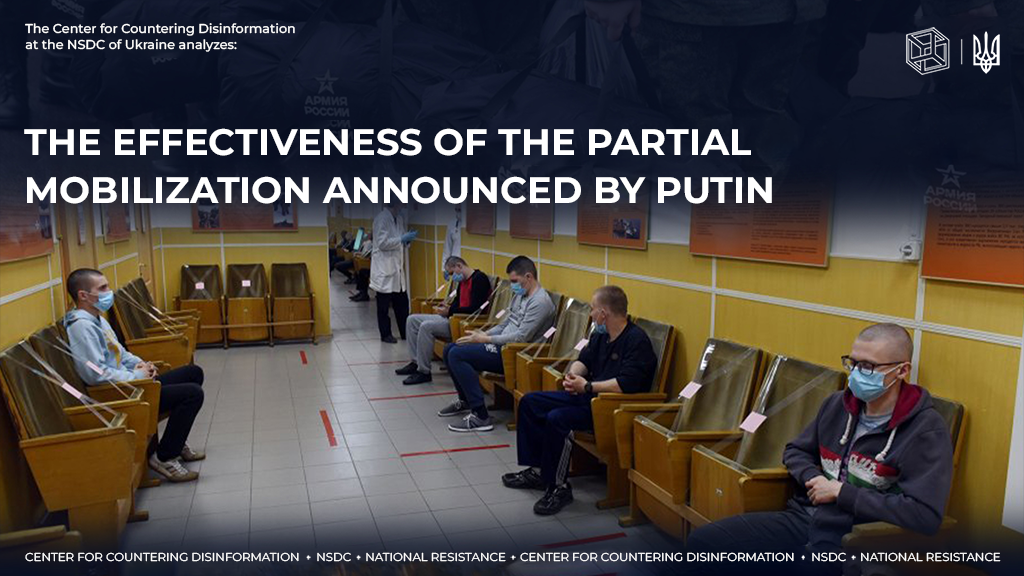❗ On September 21, russian president v.putin in his another address announced a partial mobilization, which began on the same day – russians are already being served with summonses. During the address, putin promised that only those “who are in the reserve and, first of all, those who served in the ranks of the armed forces of russia, have certain accounting and military specialties and relevant experience” will be called up. The minister of defence shoigu announced about 300,000 expected mobilized people, specifying that those who have combat experience would be mobilized.
However, the words of the president and the minister of defence about the categories of conscripts were not reflected in the relevant decree published on the kremlin’s website. This shows that the mobilization decree does not really limit the number of persons to whom it may apply. There are no deadlines or numbers of conscripts, so they will take those whom the military commissars can reach. No one guarantees that the 300,000 announced by shoigu will be the last and that only those with combat experience will be involved.
❓ Does russia have the resources to train and equip new soldiers?
❗ Military experts believe that currently russia simply does not have 300,000 people with combat experience who could be mobilized. And they justify it with the following circumstances.
✅ The Afghan war ended 33 years ago. Therefore, if a person finished his service even at the age of 20, now he is 53 and he is unlikely to be of any value to the armed forces of russia.
✅ Two Chechen wars in russia ended almost 20 years ago. About 60,000 non-commissioned officers passed through them, most of whom were under 35 at the time and cannot be mobilized now. Therefore, with the experience of the Chechen wars, only a limited number of officers can be mobilized.
✅ Among those who went to Syria, a very limited number of people have combat experience.
✅ The number of fighters of the “Wagner” PMC with actual combat experience who are still involved in the war in Ukraine is not enough to significantly influence the events at the front.
Another issue is that the russian army has serious problems with specialists who could train new personnel. After all, the authorities have promised that the recruited reservists will undergo special training before being sent on combat missions. Most of those who have already served have forgotten how to drive a tank, shoot, aim a weapon, which calls into question their ability to fight.
🔻The system of training conscripts was actually destroyed by the so-called special military operation itself, from the beginning of which almost all the officers, sergeants and foremen who were supposed to be engaged in this were either sent to war, resigned, or became combat casualties.
❗ This strategy of high-ranking military officials to send officers and sergeants of all categories to the front is aimed, first of all, at trying to achieve some urgent successes in the “special operation”. The consequences were the impossibility of the Armed Forces of the russian federation to quickly renew the quality training of new servicemen, at least to the level of combat-ready contract soldiers.
The already existing lack of officer corps in the occupation forces on the territory of Ukraine defines another problem. It is believed that in the russian army there should be approximately 10 privates for one officer. Even the minimum draft of 300,000 privates requires 30,000 officer positions in various specialties. There are no such number of additional officers in the current russian army, and an attempt to use officers from the reserve for this will face the problem of the quality of management due to the loss of their skills. In addition, the mobilized will be sent to the units that have been defeated and taken out to restore combat capability, which does not contribute to their acquisition of combat experience.
The provision of weapons and equipment to the mobilized remains under question.
🔻According to the estimates of military experts, there will be enough for the announced number of 300,000 small arms of outdated models, but they will have problems with equipment, because there are no helmets, boots and body armor in mobilization warehouses. According to preliminary forecasts, a maximum of 40-50 thousand reservists can be mobilized in the russian federation during the first wave of mobilization, since there simply will not be enough equipment for a larger number.
❗ Added to these problems is the fact that people from among the mobilized will have even less motivation to fight than active participants in the war on the russian side. This is due to the fact that the people who will be mobilized are younger than 35 years old and they are much less susceptible to the influence of kremlin propaganda regarding the goals of the war with Ukraine. In addition, one of the clauses of the decree on mobilization indicates that “contracts on military service concluded by military personnel continue to be valid until the end of the period of partial mobilization.” That is, those who decided to refuse will no longer be able to terminate the contract, which will inevitably lead to an increase in criminal cases against those who did not want to fight, and accordingly will further reduce the motivation to agree to the draft. Therefore, in response to the mass distribution of mobilization orders, a wave of mobilization evasion and anti-war protest actions under the slogan “Between death and prison, I choose prison” is predicted.
☝️ Decision on holding mobilization dictated by the defeats of the russian army during the Ukrainian counter offensive. This is a gamble on the part of the military command to show putin its effectiveness and readiness to carry out his orders to stabilize the front line.
❗However, it will not be possible to solve the shortage of experienced commanders and subordinates capable of preventing the Ukrainian military from advancing with mobilization.










